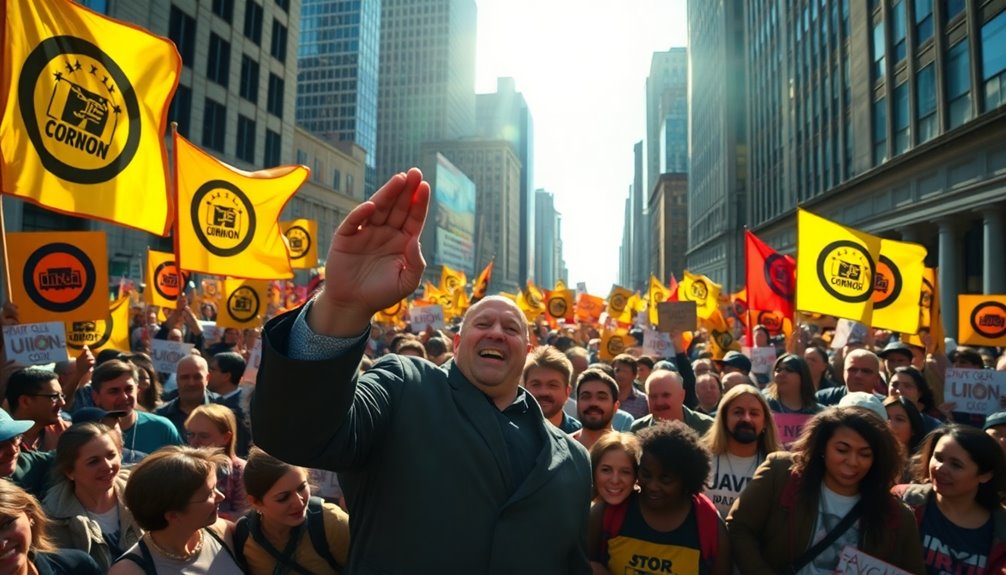Union support has skyrocketed to 70%, but Trump's Project 2025 could undermine this momentum. His policies aim to dismantle public sector unions, following the Janus v. AFSCME decision, which limits funding and membership. This means workers might face tougher conditions and fewer protections. With right-to-work laws gaining traction, the gains made through collective action could be at risk. To understand the broader implications for the labor movement, keep exploring what's happening next.
Key Takeaways
- Trump's Project 2025 threatens public sector unions by promoting policies that weaken their funding and influence through deregulation and legal scrutiny.
- The Janus v. AFSCME decision limits unions' ability to charge non-members fees, jeopardizing their financial stability and operations.
- Support for right-to-work laws undermines union membership, making it easier for employees to opt-out of union dues, further decreasing union power.
- Economic policies favoring deregulation may erode labor protections, leading to poorer working conditions and reduced bargaining power for unions.
- Declining unionization rates in a pro-union climate could exacerbate wage suppression and economic inequality, reversing recent gains in worker support.
Current Landscape of Union Support

The current landscape of union support is marked by a significant surge, with public backing reaching an impressive 70% in recent Gallup polls. You'll notice that union election petitions have jumped by 27% from FY 2023 to FY 2024, totaling 3,286 petitions. NLRB-conducted elections have more than doubled since 2021, and the union-election win rate has surpassed 70% for the first time in 15 years. However, this increase in activity is accompanied by a continued rise in employer-filed election petitions, which saw an astonishing 2,700% increase post-Cemex ruling. Yet, despite this enthusiasm, union membership remains low, with only 9.9% of wage and salary workers unionized in 2024. Public-sector workers show stronger representation, but challenges persist in the private sector.
Factors Contributing to Union Popularity

Recent developments in union support reflect a powerful shift in how workers and the public view labor organizations. High-profile victories at companies like Amazon and Starbucks have showcased the effectiveness of collective bargaining, attracting more workers to unionize. In addition, thousands of workers achieved wage gains via organizing, strikes, and union negotiations, further demonstrating the tangible benefits of union membership.
The pandemic has also played a role, as labor shortages and economic uncertainty have empowered workers to seek better conditions and job security through unions. With pro-labor policies from the Biden administration and increased media coverage, public approval for unions has soared to its highest level since 1965. This cultural shift emphasizes the importance of worker rights, linking labor issues to broader social movements. Together, these factors are driving a renewed interest in union membership and support.
Overview of Trump's Project 2025

While aiming to reshape the federal government, Trump's Project 2025 presents a comprehensive plan to dismantle or restructure various agencies. This blueprint includes a personnel database to collect resumes from conservative candidates, ensuring loyalists fill key positions.
An Administration Academy trains these individuals to effectively take over government roles. The initiative also features a "First 180 Days Playbook," detailing immediate actions for a new administration. Notably, the OMB memo fiasco highlighted the ongoing challenges in implementing these strategies.
Key policy proposals target aggressive deregulation, tax reforms, and a more stringent immigration approach. Additionally, Project 2025 aims to consolidate presidential power, reduce the federal workforce, and influence judicial actions, reflecting the conservative ideals and goals consistent with Trump's previous administration and campaign rhetoric.
Potential Impact on Public Sector Unions

As public sector unions navigate an increasingly hostile environment, the implications of Trump's policies threaten their very foundations.
The Supreme Court's Janus v. AFSCME decision has stripped unions of the ability to charge non-members fees, leading to reduced funding and weakened negotiating power. Additionally, the administration's support for right-to-work laws further undermines union membership as a condition of employment. With legal scrutiny on the rise, unions face challenges in organizing and maintaining their influence. Deregulation of labor protections could erode labor protections essential for negotiating better working conditions. As these pressures mount, public sector unions must unite and adapt to defend their rights and sustain their vital role in advocating for workers.
Economic Consequences of Anti-Union Policies

Anti-union policies have far-reaching economic consequences that directly impact workers' livelihoods and overall economic stability.
You might find that in right-to-work states, wages are about 3.2% lower than in non-right-to-work areas. This wage suppression contributes to economic inequality, as unions traditionally help reduce income disparities. Right-to-work laws require unions to provide free services to all employees, which can exacerbate the challenges faced by organized labor.
Furthermore, the promise of job growth from these laws is misleading; there's no significant employment difference between right-to-work and non-right-to-work states.
As unionization rates decline, you may face fewer benefits and increased economic vulnerability during downturns.
Ultimately, these policies primarily benefit business owners, transferring wealth away from workers and taxpayers, while exacerbating existing racial and gender inequities in the labor market.
Media's Role in Shaping Public Perception

The economic consequences of anti-union policies highlight the importance of understanding how media shapes public perception of labor issues.
Media plays a crucial role in influencing your beliefs about unions by framing narratives and selecting which stories to tell. As you consume news, you may notice that 41% of Americans believe news organizations are gaining influence, affecting your views on labor policies. Media influences individual beliefs, attitudes, and behaviors as it shapes your understanding of labor movements. Furthermore, cybersecurity vulnerabilities can arise when misinformation spreads through digital platforms, impacting public discourse.
Social media can amplify this effect, reinforcing your existing attitudes while also polarizing opinions. When the media portrays labor movements positively, it can bolster public support, but perceived bias can undermine trust and create opposition.
Ultimately, your understanding of labor issues is significantly shaped by how the media chooses to present them. The framing of these topics can either illuminate the struggles of workers or obscure them behind sensationalist narratives. For instance, just as Wallace Shawn’s essential filmography explores the nuances of human relationships and societal structures, media portrayals can either foster empathy and awareness or reinforce stereotypes and misconceptions about labor movements and the working class. Thus, the role of media is crucial in shaping public perception and discourse around these important issues.
Future Outlook for the Labor Movement

While challenges loom on the horizon for the labor movement, the resilience and determination of workers signal a future ripe with potential.
As the National Labor Relations Board shifts to a Republican majority, you might worry about a more employer-friendly landscape. However, the surge in union election petitions and rising win rates demonstrate a growing appetite for collective action. Workers are gearing up to respond to anti-labor policies with increased organizing and solidarity. Despite geopolitical instability and economic challenges, unions are pushing for democracy and equality, advocating for underrepresented groups. With the NLRB's current struggles and public support at 70%, the labor movement has a strong foundation. Your collective voice can shape policies and ensure that the fight for workers' rights continues into the future.
Frequently Asked Questions
What Historical Events Led to the Decline of Union Support?
The decline of union support has roots in several historical events.
You'll notice that the prosperity of the 1920s, post-WWII legislation like the Taft-Hartley Act, and shifts toward a service-oriented economy all played a role.
Additionally, globalization and cultural changes emphasizing individualism over collectivism weakened unions.
Legal challenges, like right-to-work laws, further eroded their power, making it tough for unions to maintain influence in an increasingly competitive and flexible labor market.
How Do Unions Benefit the Average Worker?
You might think unions just throw parties, but they actually boost your paycheck by 10-15% and offer benefits like health insurance and retirement plans that many nonunion workers can only dream of.
With better workplace conditions and protections against unfair treatment, unions give you a powerful voice. Plus, they help reduce wage gaps, making your work environment fairer and more stable.
What Are the Most Effective Strategies for Union Organizing?
To effectively organize a union, you should focus on building strong committees that reflect your workforce's diversity.
Train your leaders on union policies and engage in regular communication through home visits and small meetings.
Demonstrate solidarity by wearing union symbols and participating in job actions.
Leverage community support and utilize social media to spread the word.
Lastly, anticipate challenges and maintain ongoing outreach to keep momentum and support high.
How Can Workers Protect Their Rights Against Anti-Union Policies?
Imagine standing up for your rights, echoing the courage of past labor leaders.
You can protect your rights against anti-union policies by organizing with your coworkers, leveraging community support, and utilizing the protections offered by the NLRA.
Stay informed about your rights, document any violations, and seek assistance from your local union or NLRB.
What Role Do International Labor Movements Play in U.S. Unions?
International labor movements play a crucial role in U.S. unions by providing solidarity and support. They help you align with global standards for fair wages and working conditions.
Conclusion
As the battle for union support intensifies, you can feel the tension in the air. Will Trump's Project 2025 truly dismantle the gains unions have fought so hard for? The stakes are high, and the future of workers hangs in the balance. With public sentiment shifting and economic consequences looming, the labor movement stands at a crossroads. What will happen next? Only time will tell, but one thing's for sure: the fight isn't over yet.
References
- https://democrats.org/news/new-polling-shows-soaring-approval-for-labor-unions-as-anti-worker-scabs-trump-and-vance-threaten-workers-rights-with-project-2025/
- https://www.poynter.org/commentary/2025/how-to-report-donald-trump-second-term-president/
- https://betterinaunion.org/project-2025
- https://www.brookings.edu/articles/a-new-era-of-reporting-under-the-trump-administration/
- https://abcnews.go.com/Business/trumps-reelection-means-union-workers-experts/story?id=115731176
- https://www.employmentlawwatch.com/2024/10/articles/employment-us/unionization-activity-continues-to-surge-in-the-u-s/
- https://jacobin.com/2025/01/trump-nlrb-unions-organizing-resistance
- https://www.epi.org/publication/millions-of-workers-millions-of-workers-want-to-join-unions-but-couldnt/
- https://truthout.org/articles/the-labor-movement-won-big-victories-in-2024-now-it-must-fend-off-trump/
- https://www.bls.gov/news.release/union2.nr0.htm









